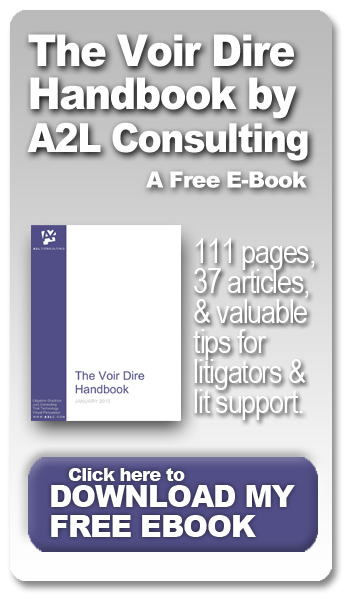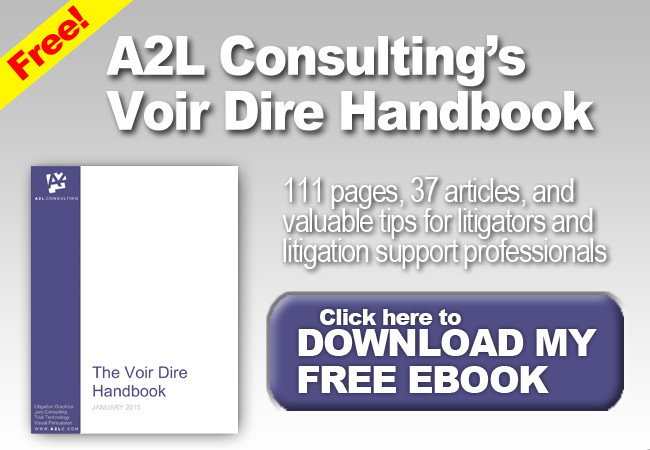by Ken Lopez
Founder/CEO
A2L Consulting
Seven of the top ten web searches that lead to a visit to our website in 2014 were related to voir dire or jury selection. These are topics that we write about frequently and assist clients with often at A2L Consulting.
To respond to the obvious demand for information about voir dire, we are today releasing our latest free e-book, The Voir Dire Handbook. This 111 page book is comprised of 37 articles about jury selection, voir dire and related topics. Like our 20+ other litigation, persuasion, psychology and presentation-focused e-books, The Voir Dire Handbook is a free download with no strings attached.
Although attorney-run voir dire does not occur in every venue, some level of voir dire is almost always possible. Sometimes it's conducted by a judge. Sometimes it's run almost entirely by the lawyers. Because the composition of a jury can dramatically affect the outcome of the case, it is vitally important to get voir dire right and use whatever tools are available for doing so. Even in federal court, you often have more options available than many believe.
This one-of-a-kind and brand-new book will be helpful to junior and veteran courtroom practitioners alike. Some of the topics covered include:
- 7 Tips to Take Dire out of Voir Dire
- 5 Questions to Ask in Voir Dire Always
- 5 Voir Dire Questions to Avoid
- Jury Selection: Should You Follow Your Instincts About a Juror
- 10 Signs of a Good Jury Questionnaire
- Why Do I Need A Mock Trial If There Is No Real Voir Dire
- Jury Selection Experts: True or False?
- 10 Ways to Spot Your Jury Foreman
- and 29 other useful articles.
"Voir dire" refers to the process by which prospective jurors are questioned to uncover biases which may automatically require their rejection from jury service in a given trial (through strikes for "cause") or allow attorneys to deselect them from a jury (through "peremptory" challenges). The goal of voir dire is to eliminate jurors who pose the most risk to a client, whether in liability or damages. Those who are left constitute the jury. Given how limited a client's control is over who shows up in the pool and, in some venues, the questions that can be asked, the ability to smart bomb, i.e., hone in on the worst jurors and get rid of them, is vitally important.
Proper voir dire is not something that one plans for the day before or even the morning of trial. In cases where what is at stake warrants it, months can be spent developing the best plan for jury selection through a mock trial process to learn the traits that mark adverse jurors and then ways to strategically incorporate that knowledge into the voir dire process.
The articles contained in this book share lessons my colleagues and I have learned from being engaged in thousands of trial and jury consulting engagements over careers that span many decades. We cannot tell you how many times we have observed attorneys making obvious mistakes in voir dire -- all avoidable, such as revealing their fans rather than their enemies, or talking more than listening, or asking one too many questions of good jurors. Don't be one of them.
You may download The Voir Dire Handbook by clicking here or on the image below. Your feedback and discussion are welcome and encouraged.






Leave a Comment